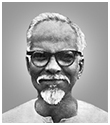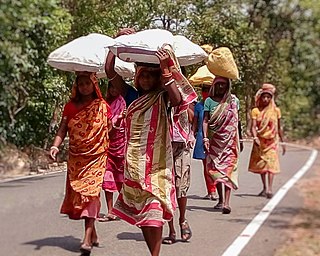Related Research Articles

Kendujhar District, is an administrative district of Odisha. The district is one of the fifth Scheduled Areas of Odisha. The town of Kendujhar is the district headquarters. The district has three sub-divisions, Anandapur, Champua, and Kendujhar.
The Karan or Karana is a community of scribes found in the state of Odisha in India. The post of Karana used to be a professional designation that was occupied by literate members of the lower as well as the higher castes. They also held Karanam post in some parts of Andhra Pradesh, where they speak Odia and played the similar role in Odisha as that of the Kayasthas of West Bengal and Bihar. Traditionally they were the official record-keepers in the royal courts of the Odia princely states historically. Today they are a politically dominant community and have reigned over the politics of Odisha for 40 years.

Nabakrushna Choudhuri was an Indian politician and activist. He served as Chief Minister of the Indian state of Odisha. He was a freedom fighter who participated in the Non-cooperation Movement, the Civil Disobedience movement, and the Peasant movement.
The red corridor, also called the red zone or according to the Naxalite–Maoist parlance the Compact Revolutionary Zone, is the region in the eastern, central and the southern parts of India where the Naxalite–Maoist insurgency has the strongest presence. It has been steadily diminishing in terms of geographical coverage and number of violent incidents, and in 2021 it was confined to 25 "most affected" and 70 "total affected" districts across 10 states in two coal rich, remote, forested hilly clusters in and around Dandakaranya-Chhattisgarh-Odisha region and tri-junction area of Jharkhand-Bihar and-West Bengal.

Bagata people are one of the tribal ethnic groups of India, mainly concentrated in Andhrapradesh and Odisha. As per the Indian constitution, they are designated as Scheduled Tribe for affirmative action.

Bhunjias, are an ethnic group found in India mainly reside in Sunabeda plateau in Odisha and Chhattisgarh. They are mostly found in Nuapada district, which is roughly between 22° 55′ N and 21° 30′ N latitude and 82° 35′ E longitude. It was a part of Khariar Zamindari, which formed the eastern and the southeastern region of Raipur district of Chhattisgarh division in Central Province till 1 April 1936, when it was transferred to Odisha on its creation. It is now in Komna block of Nuapada district in Orissa. In Chhattisgarh they are found in Raipur district.
Bauri (Bengali:বাউরী) is a community of indigenous people primarily residing in Bengal, and considered as one of the Scheduled Castes of India. The Bauris belong to the Bhil tribe. They are usually involved in activities like farming. The Bauris of Purbo Tila Moulvibazar in Bangladesh are usually involved in medicinal practices. The prime festivals they celebrate are known as Mansa Puja, Durga Puja and Kali Puja.
Kumar Suresh Singh (1935–2006) commonly known as K. S. Singh, was an Indian Administrative Service officer, who served as a Commissioner of Chhotanagpur (1978–80) and Director-General of the Anthropological Survey of India. He is known principally for his oversight and editorship of the People of India survey and for his studies of tribal history.
The Rautia is a Sadan Caste community found in the states of Jharkhand, Chhatishgarh and Odisha in India.
Relli is a social group of South Indians who reside in the Indian states of Andhra Pradesh, Odisha, West bengal, and Chhattisgarh. They are classified as a Scheduled Caste.
The Kudmi Mahato are a tribal community in the states of Jharkhand, West Bengal and Odisha of India. They are primarily agriculturalist.
The Sounti are an Indo-Aryan ethnic group found mainly in the Kendujhar and Mayurbhanj districts of Odisha. The 2011 census showed their population to be around 112,803. They are classified as a Scheduled Tribe by the Indian government.
Gopal or Gouda is an Indian caste, from Odisha State in East India. Their traditional occupations include dairy farming, cattle herding, cultivation and carrying palanquins of deities. They also worked as Paikas (soldiers) under the kings. Gopal is the name of the milkmen or herdsmen caste in Odisha, which is known by other names in various parts of India.
The Binjhia is an ethnic group found in Odisha and Jharkhand. The 2011 census showed their population to be around 25,835. They are classified as a Scheduled Tribe by the Indian government.
The behera is a popular Odia title, Anciently, Dala-Behera was an honorific title reserved for the leader of a group of soldiers.
Patra or Patara is a caste found in the Odisha State of India. They are a synonym of Kapudia community, both are same by culture and profession. Traditionally they are petty traders inside and outside of the village. They trade in cotton and silk yarn, vermilion, and sacred threads meant for various rites and rituals. They are also required to supply these materials to the village deity and also to the Hindu caste people of the village on various ceremonial such as religious occasions.
The Kaikadi are a community in the Indian states of Maharashtra and Karnataka. Their name is derived from kai and kade, while the community derives its name from kai and kadi. Traditionally, they were nomadic, mainly wandering in the Vidarbha region of the state, but most have now settled down. They speak Kaikadi, a Dravidian language closely related to Tamil with significant Indo-Aryan admixture. They practice the puberty function like other Tamil communities.

Bagal is a cattle herding caste of East India. Bagal people are living in the state of West Bengal, Jharkhand and Odisha. They use Kudmali/ Manbhumi dialect of Bengali as mother tongue and use Bengali, Hindi and Odia language to communicate with the society.
Rujwars or Rajuar is a shifting cultivation community. The people of this community mainly live in Bihar, Jharkhand, Madhya Pradesh, Odisha and West Bengal. In Odisha, they are recognized as a Scheduled Tribe, while in Bihar, Jharkhand, and West Bengal, they are classified as Scheduled Caste. In other states, the community is considered part of the Other Backward Classes (OBC) or general population.
References
- ↑ "THE CONSTITUTION (SCHEDULED CASTES) ORDER, 1950" (PDF). 11 August 1950.
- ↑ Adibasi. Tribal Research Bureau, Orissa. 1969. p. 57.
- ↑ Singh, K.S.; Anthropological Survey of India (1992). People of India: Odisha (2 pts.). Anthropological Survey of India. p. 1408. ISBN 978-81-7046-294-1 . Retrieved 2023-08-03.
- ↑ Orissa (India). Tribal Research Bureau (1969). Adibasi. Tribal Research Bureau, Orissa. Retrieved 2023-08-03.
- ↑ Singh, K.S.; Anthropological Survey of India (1998). India's Communities. Anthropological Survey of India. ISBN 978-0-19-563354-2 . Retrieved 2023-08-06.
- ↑ Alte, I.D. (1992). Rural Employment of Scheduled Castes. Deep & Deep Publications. p. 58. ISBN 978-81-7100-378-5 . Retrieved 2023-08-05.
This article needs additional or more specific categories .(March 2024) |